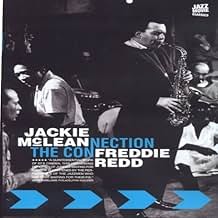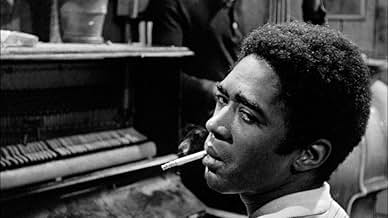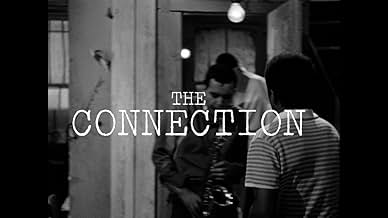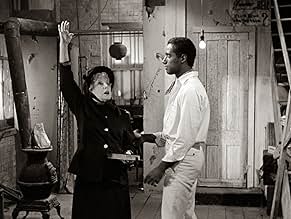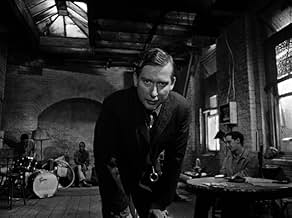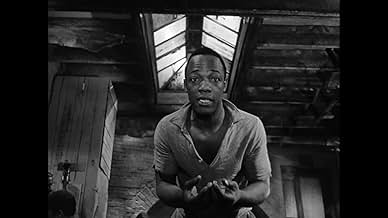IMDb रेटिंग
7.0/10
1.1 हज़ार
आपकी रेटिंग
अपनी भाषा में प्लॉट जोड़ेंMen sent their own way await heroin in Leach's apartment.Men sent their own way await heroin in Leach's apartment.Men sent their own way await heroin in Leach's apartment.
Jerome Raphael
- Solly
- (as Jerome Raphel)
Jim Anderson
- Sam
- (as James Anderson)
Roscoe Lee Browne
- J.J. Burden
- (as Roscoe Browne)
फ़ीचर्ड समीक्षाएं
I first saw this movie in 1963 by hassling the cashier into selling me a ticket though I was under 18. I can't remember what I expected, but it was so interesting to me that I came back with a couple of underage friends--and got in again. This is a very sophisticated film not only for its time, but for now. There is no surprise ending or plot twist, but the use of the film-within-a-film allows the characters to relate to the outside world even though all the action takes place within one studio apartment. And what they have to say makes as much sense now as it did then. This is a film that could be re-shot with a minor change of clothing style and would look and sound cutting edge.
While "Traffic", in its glossy, artfully edited, mainstream way, explores the glossy, mainstream life of at least some drug traffickers, "The Connection", in its gritty, black-and-white, hand-held way, explores the gritty, hand-held life of at least some of the customers.
I would recommend this film for anyone who is interested in serious exploration of the drug culture. For people who think "Trainspotting" too mainstream--or at least too narrow in approach. "The Connection", too, is narrow, but it helps round out the picture begun by "Traffic" and"Trainspotting".
While "Traffic", in its glossy, artfully edited, mainstream way, explores the glossy, mainstream life of at least some drug traffickers, "The Connection", in its gritty, black-and-white, hand-held way, explores the gritty, hand-held life of at least some of the customers.
I would recommend this film for anyone who is interested in serious exploration of the drug culture. For people who think "Trainspotting" too mainstream--or at least too narrow in approach. "The Connection", too, is narrow, but it helps round out the picture begun by "Traffic" and"Trainspotting".
The opening text states that documentary filmmaker Jim Dunn gave all the footage to J. J. Burden who claims responsibility for putting this film together. Rather quickly, an experienced modern film watcher can pick out the obvious clues that this is a play rather than a documentary. The actors are talking too well and clearly. They are professional actors doing lines from a script, not lines lines. They don't look bad enough. Some of the actors have good hair. The black guys probably didn't trim for a week. That's not junkie enough. Then, there is the room itself. It looks like a stage. Look out windows. The fake backdrop is right there. The big giveaway is that the lighting is too good. The audience can see everything. Finally, the traditional closing credits tell the story. Then I consider the era and maybe the closing credits weren't there. Back then, the audience was probably not looking for the found footage genre. They could be fooled. Of course, Fargo still got people in the 90's although they didn't claim that it was a documentary. Looking at this like a stage play. I can see this off-Broadway. It could be edgy enough to get some attention. Like I said, the actors are solid professionals. This may be experimental back in the day, but it is well-made.
I don't know why anyone would call this realistic. It looks and feels like a play...the "acting", the overblown dialogue (almost Odets-like), etc. And unless you were a junkie in 1961, how would you know if it's realistic? And Sister Salvation? How could that possibly be real?! Noone is that clueless.
It's obviously dated for many reasons....the "lingo", the lack of serious profanity, the odd discussion of homosexuality.
Still, the film hooks you in...and I'm not exactly sure why. I guess it never really slows down. The camera tricks are cool, the band is great, some good dialogue. And the acting and characters are interesting, if not realistic.
Worth seeing...
It's obviously dated for many reasons....the "lingo", the lack of serious profanity, the odd discussion of homosexuality.
Still, the film hooks you in...and I'm not exactly sure why. I guess it never really slows down. The camera tricks are cool, the band is great, some good dialogue. And the acting and characters are interesting, if not realistic.
Worth seeing...
This is a very difficult film, austere and hard, but after about ten minutes you can calibrate yourself to its rhythm, which is slow -- or, not so much slow as not fast, with extremely long takes in a one-room setting. The film, which is about a group of jazz musicians waiting for "the connection" (heroin) in an apartment, is essentially a filmed piece of experimental theater; it's very interesting, I think, and valuable for its honest portrayals of blacks (not all of the characters are black, but those who are are allowed to give equal amounts of monologues to the camera). The film itself, which is a product of the beat culture, is an experiment in subtle documentary satire -- the film is a film that's being made by a documentarian and his camera assistant; the documentarian becomes involved in the "film" himself by interacting with the musicians, trying to get them to act naturally for the camera by saying he's one of them, that he "reads" them. (The film is also a kind of Method film in the sense that the performances are strained and melodramatic -- the main character who owns the apartment has a boil that makes him scream at a few points -- and that everything is about the documentarian retaining emotional truth.) As the documentarian gets involved with the group (and after the connection arrives, with a female religious preacher in toe), the film feels almost like a public service announcement. It's a really fascinating document. 9/10
And what a stupid comment by a previous viewer. "Are all jazz musicians heroin attacks?" C'mon, there isn't a trend here, and perhaps you don't like jazz because you have no taste in music. Anyway, Shirley Clarke's cinema verite'style is put to the test , as we witness some sleazed-out New Yorkers in their subterranean dwelling, as they await their heroin "connection" -the mysterious Cowboy, played by Clarke's real-life lover, Carl Lee.
क्या आपको पता है
- ट्रिवियाThis film was held up for release after the Board of Regents of the Motion Picture Division of New York State's Dept. of Education viewed the film and refused to grant it a license to be commercially shown. This was mostly due to the repeated use (seven times) of a four-letter word that rhymes with "hit" and is used as a slang synonym for heroin. The film was judged obscene but opened without a license anyway at the D.W. Griffith Theater on October 3, 1962, only to receive several bad reviews from the major N.Y. film critics. Director Shirley Clarke sued and a month later, the highest court in the state reversed the decision of the Board of Regents. However, the reputation of the film was already damaged and to this day, it has never recouped its original $167,000 budget.
- कनेक्शनFeatured in Cinéastes de notre temps: "Rome brûle" (Portrait de Shirley Clarke) (1970)
टॉप पसंद
रेटिंग देने के लिए साइन-इन करें और वैयक्तिकृत सुझावों के लिए वॉचलिस्ट करें
विवरण
- रिलीज़ की तारीख़
- कंट्री ऑफ़ ओरिजिन
- आधिकारिक साइट
- भाषा
- इस रूप में भी जाना जाता है
- La conexión
- फ़िल्माने की जगहें
- उत्पादन कंपनियां
- IMDbPro पर और कंपनी क्रेडिट देखें
बॉक्स ऑफ़िस
- बजट
- $1,67,000(अनुमानित)
- चलने की अवधि1 घंटा 50 मिनट
- रंग
- पक्ष अनुपात
- 1.37 : 1
इस पेज में योगदान दें
किसी बदलाव का सुझाव दें या अनुपलब्ध कॉन्टेंट जोड़ें


